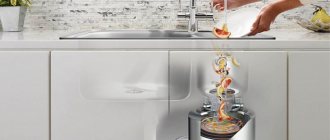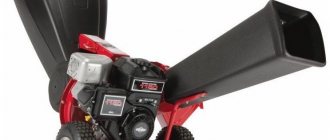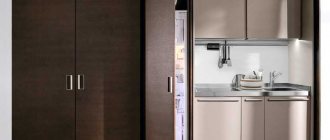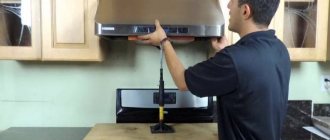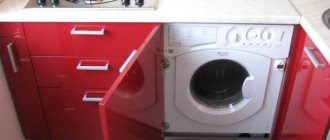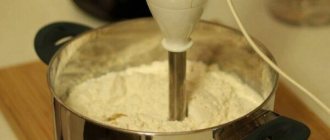A disposer is a shredder of household organic waste and food debris installed directly under the kitchen sink.
Its purpose is to transform food waste into a mass, which, when washed off with water, easily goes down the drain.
Such a kitchen shredder will help people who are concerned about the problem of separate waste collection, because the question of where to put food waste will lose its relevance.
What it is?
Most people collect food scraps in buckets before washing dishes and then start washing.
The Disposer is designed to eliminate this operation in the kitchen. With its use, the need for waste buckets and scraping leftover food from plates disappears.
Before using the disposer, meshes were installed in sinks to prevent waste from entering the drain.
Now the mesh is removed completely and everything is done to ensure the best penetration of food debris into the sewer system.
In essence, the action of a kitchen disposer resembles a meat grinder through which food remains are passed , turning into a paste-like mass that is easily washed off with water. The device is installed directly under the sink and integrated into the drainage system.
Myths about shredders
Electric food waste shredder has been on the market for quite some time. Despite this, it is not widely used, and the knowledge of many is based on myths and speculation.
Myth No. 1. Unpleasant smell from the sink
The causes of unpleasant smell from the sink are:
- incorrect connection of the device;
- improper use of the device.
The grinder is connected to the sewerage system using an S-shaped siphon. Often, the chopper is connected directly to the sewerage system, citing the fact that the device is a siphon.
This is actually not true. Since, with a direct connection, all odors in the sewer will freely penetrate into the kitchen.
What kind of waste does a kitchen recycler process?
Shredder manufacturers recommend using disposers for almost all waste , including:
- fruits and vegetables;
- rinds of watermelons, melons, pumpkins;
- chicken and fish bones;
- any cereals, bakery and pasta products;
- shells of all types of nuts;
- napkins and cigarette butts.
There is a long list of items that should not be thrown down the drain in hopes of being shredded in a disposer.
First of all, these are different:
- films;
- plastics;
- fabrics;
- rubber and metal products;
- products with long fibers or strands;
- hair.
Disposing of the listed materials into the disposer will result in equipment failure.
As a rule, all disposers are equipped with a locking system. This means that if a foreign object or too hard bone gets into it, a system is activated that turns off the device.
Additional criteria
Some devices may have additional features.
If you need to get rid of odors from the sink drain hole, as well as avoid the growth of bacteria, you should choose models with a special antibacterial coating, which is located in the inside of the body.
It all depends on the individual preferences and needs of the buyer.
The power button can be built into the countertop next to the sink. The switch can also be the chopper cover, the rotation of which turns on the device.
Manufacturers have added additional functions to modern models: pneumatic switch and overload protection.
Disc rotation speed
Directly depends on engine power. To consume a large and uninterrupted flow of waste, a very powerful motor will be required, which will set the maximum speed of rotation of the disks.
The faster the discs move, the more intense the grinding of waste.
It is very important when processing solid products. However, in order to avoid breakdown of such systems, you should avoid getting metal, glass, plastic and other small, but quite durable objects into them. Most modern devices are equipped with an automatic shutdown system, but it’s still not worth the risk.
Models with adjustable speed are convenient. This makes it possible to save electricity when processing soft organic matter.
Power
Selected depending on the purpose of the equipment. High power will be relevant for using the chopper in large bars or restaurants. For home consumption, using a lower power rating is sufficient, which will save utility bills.
The model is selected depending on the scenario for using the device (professional, household), the number of family members and the amount of waste.
The more powerful the unit, the more noise it makes, which is not very good for the nervous system of household members. The sounds they make resemble the operation of an electric meat grinder, which is constantly on. Therefore, it is not recommended to use food waste shredders with continuous operation in sinks at home.
Cylinder capacity
This aspect also depends on the scale of consumption of the disposer. The more and more often the device is used, the larger the size of the crushing chamber is needed. The more power, the larger the cylinder will be. The size of the grinding mechanism depends on its size. These are interconnected things by which you can easily determine the purpose of the unit.
The larger the disposer, the higher the processing power.
To ensure that the cam crushing mechanism and chamber are not subject to rust and corrosion, and also do not quickly fail, they are made of durable stainless steel.
For catering, it is better to use powerful electric models with continuous operation. A mechanical option, which involves portioned loading of products, is also quite suitable for home use. However, it does not require any electricity consumption. Such models are inappropriate for large waste flows, since it is not very convenient to measure out a certain amount of products and only then start the mechanism.
Most modifications have a capacity of 0.7-1.5 liters.
Types and principle of operation
Next, we will describe the operating principle of a food waste shredder and a food destroyer for the sink, or, as it is also called, a disposer.
The vast majority of disposer models are equipped with an electric drive . But mechanical models that operate under the influence of water pressure are also used.
How do mechanical models work?
For successful operation of mechanical shredders, a water pressure of at least 4 bar is required. With a normally functioning plumbing system, this is the actual water pressure in the tap.
But the pressure indicator does not depend on the residents; a decrease in water pressure is especially often observed on the upper floors of houses.
Of course, the shredder will have no effect if the water pressure in the tap is low.
Electric shredders
Electric kitchen dispensers are in greatest demand.
The dispenser equipped with an electric drive does not depend on the water pressure in the tap . It just needs to be launched by pressing a button.
Batch loading models load waste first. With continuous loading, the shredder is started first, and then waste is placed into it for shredding.
There are also automatic models that do not require pressing a button, but turn on when waste gets into them.
How a food waste shredder works - the principle and what it is needed for
The food waste disposer was invented in the USA, where today it is strongly recommended by the Ministry of Health for installation in every kitchen sink.
Firstly, it is very hygienic. The chopper gets rid of the unpleasant odor and midges that appear from time to time in the trash can with food waste.
Secondly, these devices prevent sewer blockages.
Modern shredders easily cope with cores and skins of fruits and vegetables, small bones of birds, animals and fish, bread crusts, eggshells, herbs, nut shells, berry and fruit seeds.
Every year, food waste shredders are becoming more and more popular in Russia. Housewives who have encountered this device at least once dream of installing it in their own sink.
The principle of operation is that the device located directly under the sink is equipped with several knives that move and crush all food waste that falls under the blades.
There are models in which food waste is mixed with water and rotated at high speed, crushed by friction against the walls, somewhat reminiscent of a grater.
Only after being reduced into small grains does food waste flow from the grinder into the sewer pipe.
The device is completely safe for home use, the knives are securely covered, and both adults and children can use it.
Shredder device
Based on the principle of operation, a food waste chopper most closely resembles a centrifugal juicer. Inside the chamber there is a crushing disk with “cams”, and the walls of the chamber are made in the form of a stationary grater. During the operation of the disposer, waste is ground and crushed, after which it is washed off with running water into the sewer.
Let us separately mention that previously mechanical grinders were popular, which were driven not by electricity, but by a stream of water. However, in our time it is not possible to find such devices on sale, and therefore there is no point in discussing them.
Another “outdated” option that sometimes comes on sale is a shredder with batch loading: waste must be loaded into it in small portions and only then the device should be started. The standard today are grinders with continuous loading - such devices “devour” food waste as it enters the chamber of the device.
Connection features
Installing a disposer does not require specific knowledge or a special level of skill; almost anyone can do it. Sinks of older models can cause some difficulty, since almost all grinders are designed for modern sinks with a European drain with a diameter of 89-90 mm. Some models can be installed on a sink with a 50mm drain hole (provided the sink is made of stainless steel), but we would recommend simply replacing the sink with a new one if you are still using a sink with a small drain hole diameter.
Before choosing a chopper (and before starting installation), you should make sure that there is enough space for it: the barrel of the device’s working chamber may be too “pot-bellied”, so it would not be superfluous to check all possible dimensions:
- height and width of the installed device
- distance from the bottom of the sink to the center line of the outlet
- distance from the center of the drain hole to the end of the pipe
- distance from the center line of the device to the center line of the device connection
You also need to ensure that the drain pipe level is at the appropriate height (i.e. below the disposer outlet).
By the way, the trash can, traditionally placed under the sink, will have to be moved to another location after installing the shredder! Be prepared for such a turn!
One of the options for connecting a chopper
To operate the shredder, you will need an electrical outlet located in a place where water cannot enter. Preferably with an appropriate degree of water protection.
During the installation of the chopper, as a rule, you will have to drill a hole for the pneumatic button in the countertop, turn off the water supply, dismantle the water seal, dismantle the sink outlet and replace it with the upper part of the chopper with rubber gaskets, secure the disposer, then connect the siphon and install a switch-button by connecting the air hose.
This description may look scary, but in practice there are not many potential difficulties here: just watch a training video on Youtube to make sure that, provided that communications are properly installed, problems should not arise even for not very experienced users who have minimal experience in handling tools.
Control method
The standard control method for household shredders is a pneumatic button (actually a small manual air pump), which is displayed on the countertop. A hose is connected to this button, which transmits the created air pressure to the chopper body, where a similar response device presses the electric button. This design allows you not to be afraid of a short circuit or electric shock due to the fact that the button is flooded with water.
The most modern shredders allow remote control in addition to the standard button: some manufacturers provide their shredders with a remote control, while other users prefer to set up their own smart socket, controlled by a remote switch or even via a smartphone.
It is clear that the choice of how to control the device remains at the discretion of the user: on the one hand, not everyone is happy with the prospect of having an additional remote control in the house, on the other hand, some categorically do not want to drill an extra hole in an expensive countertop.
Device body material
When choosing a shredder, you should pay attention to the body of the device. More expensive and “serious” shredders have a metal body, while more budget and low-power models are often made in a plastic case. We will not consider the presence of a plastic case to be a serious disadvantage (just as the presence of a metal case is a serious advantage). Rather, the presence of a metal body is an indication that the device belongs to a more “professional” category, while a plastic case often indicates that this is a more “household” shredder.
One way or another, the inner chamber will still be made of stainless steel, so the material of the case, in our opinion, does not play a significant role.
Chamber volume and device dimensions
The dimensions of the shredder determine not only the weight of the device, but also the volume of the working chamber, and therefore the amount of waste that can be shredded at one time, which in practice can be especially important for those who cook a lot.
Selection criteria and safety
The selection criteria for modern models are based on ease of use and cost of equipment.
In addition, it is worth paying attention to a number of indicators :
- chopper power;
- rotational speed;
- anti-corrosion coating;
- launch type;
- presence of reverse;
- availability of a repair service nearby;
- availability of consumables and spare parts;
- equipment noise during operation;
- lifetime.
A very important point - the disposer is considered an absolutely safe device ; any model is installed so that the cutting working parts of the equipment are inaccessible during operation.
Shredder selection criteria
Bandwidth
This parameter is determined by the capacity of the loading chamber: the smaller it is, the longer it will take to grind the waste. The minimum chamber capacity of shredders is 0.5 liters. If you have a large family, then it is wise to invest in a device with a larger chamber. For example, a disposer with a 1-liter chamber can process up to 8 kg of waste in a couple of minutes.
Motor power
The power determines what kind of waste the shredder can handle. For home use, devices with a power from 360 to 560 W are suitable. High-power models can even shred chicken bones or banana peels. Absolutely all disposers cope with peeling vegetables and fruits, herbs, eggshells, watermelon rinds, fruit or berry seeds. From non-food waste, disposable paper towels, napkins, and cigarette butts can be sent to the shredder.
Power also affects how quickly the device copes with waste, durability and volumes of shredded material.
It is not recommended to grind foods with a fibrous structure, such as banana peels and corn cobs, tubular bones, be careful with onion peels
Please note that it cannot be processed using a shredder. *pineapple *pumpkin *asparagus *artichokes *clam shells *medicines *metal objects and plastic.
Grinding degree
Choosing a device with several degrees of grinding is justified when there are problems with sewer capacity. For example, in private houses with a closed system for treating domestic wastewater, septic tanks require the finest possible grinding of household waste.
Pneumatic button
It is available in advanced models. If possible, we recommend choosing disposers with just such a button. This is a very useful thing that makes using the device convenient and safe. The pneumatic switch button is built into the countertop next to the sink (or into the sink itself) and is connected to the disposer with an air hose, and not with an electric wire, as in traditional models. Therefore, you can safely turn on the device with wet hands and not be afraid of water getting on the button while using the sink.
Noise level
The operating disposer is quite noisy. If you have a studio kitchen, we recommend choosing a chopper with additional sound insulation. These are more expensive, but they won't annoy you and your family by drowning out the TV. In ordinary kitchens, installing a low-noise appliance is a matter of personal comfort.
Shredder weight
Important when choosing the type of kitchen sink installation. When equipping an under-table mounted sink with a shredder, you should coordinate your wishes with the furniture showroom technologist.
Additional functions
Some models of shredders have a useful “Auto reverse” function, i.e. reverse rotation. It helps to clear a device that is clogged from the inside, thereby extending its service life.
Is a disposer really necessary?
The introduction of disposers into the everyday life of every family is not yet supported at the state level. The reason is that authorities fear a significant increase in the load on sewerage and treatment systems.
The authorities of large American cities experienced similar doubts half a century ago. They conducted an experiment on the use of disposers in order to determine the consequences on sewer systems.
The result was surprisingly favorable:
- water consumption increased slightly, which did not have any negative impact;
- the energy consumption for operating the disposer turned out to be comparable to using one additional light bulb;
- The problem of accumulation of wastewater saturated with biological waste was solved by installing digesters for biogas production.
The conclusion that the Americans came to is that the use of disposers not only does not have a negative impact , but can also bring direct economic and environmental benefits.
The American Ministry of Health recommended installing disposers in all houses under construction; today more than half of the kitchens of American houses are equipped with this device.
Benefits of use
Garbage reform today is at least puzzling due to its ill-conceived nature.
Russians, in principle, are not against separate waste collection, but do not see any practical sense in this idea of the authorities.
The waste recycling system is not debugged and not thought through to its logical conclusion.
Perhaps reform ideas were calculated by people who had never washed dishes or cooked food.
Because the biggest difficulty of separate collection lies precisely in separating food products from other solid waste.
Biodegradable food scraps account for approximately 30% of all waste.
If these unused products go down the drain and are then turned into biogas , then the problem of waste separation will be practically solved. At least for big cities and the capital.
It's not at all difficult to put paper and plastic in separate bags, because the main problem - leftover food - goes down the drain.
To be completely honest, it is unlikely that anyone will reach into a garbage bag to sort through its contents again if they accidentally threw leftover food into it.
Positive consequences of using disposers in Moscow apartments:
- about 2.5 million tons of food waste annually will be processed into biogas at mini-thermal power plants;
- the amount of waste disposed of in landfills will be reduced by the same amount;
- processed waste in the form of biogas will be used for heating and electricity generation;
- in addition to gas, food scraps can be processed into high-quality fertile soil and a number of other necessary goods and products;
- the use of household shredders will simply make life easier for millions of housewives in Moscow and other large cities.
The negative side of the issue is the price of disposers. Still, the cost of one device from 10 thousand rubles is expensive for most people.
To quickly introduce disposers into the everyday life of every person, it is necessary to radically reduce the price of the product and organize installation and repair services.
You can use the disposer in an apartment, private house, or country house.
The device is not in demand only in the case of using household food waste in a subsidiary farm - for pet food, for the production of biofertilizers, or if there are other alternative options for getting rid of kitchen food scraps.
